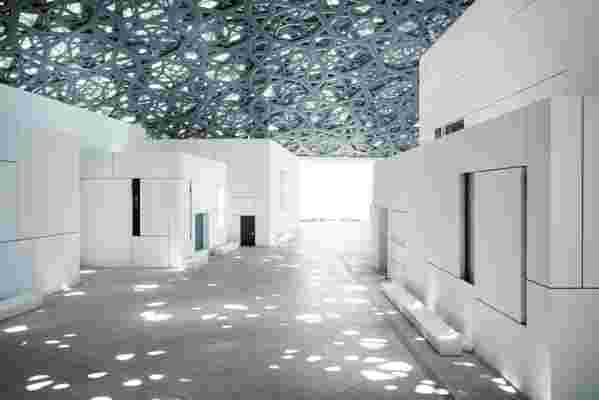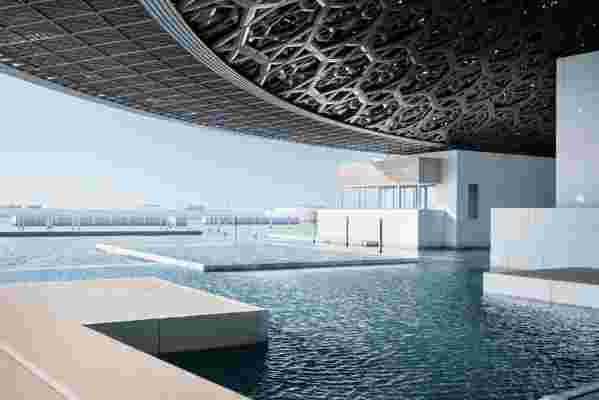Billed as the first museum of its kind in the Arab world, the long-delayed Louvre Abu Dhabi officially opens on November 11, the first of the trifecta of world-class museums to open on Saadiyat Island along with the Zayed National Museum and the Guggenheim.
It will not only seek to showcase cultural works of art, but also share human stories across civilizations and cultures.
The Pritzker Prize–winning architect Jean Nouvel designed the museum city after being inspired by the concept of a medina, considered the ancient quarter of many Arab cities. Nouvel constructed a 591-foot silvery metal dome comprised of 7,850 stars in a complex geometric pattern.
When sunlight falls through it, the design creates a moving “rain of light” underneath the dome, a nod to the natural elements found in the United Arab Emirates (UAE), notably swaying palm trees in oases. Artworks and artifacts found in this Louvre span the entirety of human existence, and the museum will have a gallery dedicated to universal religions.

Here, a translated and condensed interview with Nouvel:
Architectural Digest: The new Louvre with its truly global aesthetic debuts at a very significant time in the entire overall political framework. Did you design the structure with a conscious view of global harmony?
Jean Nouvel: When I started working on this project, I did not know it would be the Louvre , but that it would become a museum of civilizations—the plural of this word is important.
I wanted a strong symbol, an immediate dialogue, a powerful spiritual dimension.
I then wanted an architecture that resonates with the history of the place by providing a direct echo in Arab architecture, but one that equally addresses universality. It is this synthesis that must be found.
And because architecture is an art, it would be quite mysterious, alluring enough to tempt the public to get lost and to go seek his or her own answers.
AD: How does this achievement measure up for you?
JN: The Louvre Abu Dhabi is one of the best works I have been fortunate to achieve.
It is beautiful commission not only to build the museum—a gift to future generations—but also to imagine an architectural gesture that will characterize Abu Dhabi and the UAE. An architectural achievement is always a kind of petrification of a given time and of a civilization.Imagine a museum at the beginning of the 21st century that will speak about the world through the ages, opening windows and binding civilizations. It is a wonderful opportunity for an architect like me!

AD: There are 7,850 stars on the ceiling. How did you arrive at this number, and is it based on the history of Abu Dhabi and folklore?
JN: I wanted to fuse sky, water, sand and something that is between eternity and the moment. This blend offers a spirituality of its own.
A day filled with light is one of the signature effects of this building: The dome feels fresh and inspired by the shade of moving palm trees. Visitors will also feel the ambience of a temperature drop and the play of light, both of which are extremely present. When you are under the dome of the Louvre Abu Dhabi, you are immersed in a microclimate; the sea breeze that wafts in reinforces this impression of relative freshness.
The dome is comprised of eight layers superimposed on one another, and this is evocative of Arab architecture. As a contextual architect, how could it be otherwise?
Each star form is unique, and the result is both a technological and aesthetic feat: a rain of light. This will be the same depending on the time, day, and month of the year. Even our most extensive calculations do not allow us to know exactly what will be all the feasible combinations of this pattern of “light rain.” Sometimes, in the solar noon, the brightness is so dense that it looks like light stalactites are piercing the dome.

AD: What, in your opinion, is the biggest difference between the Louvre in Abu Dhabi compared to the one in Paris?
JN: The Louvre in Paris existed when the kings of France used it as a residence until Louis XIV, worried about attempts made at his court, decided to build Versailles and make that his new place of power.
In contrast, what influenced most the Louvre Abu Dhabi is the nature of its collections and what should be a museum of civilizations today: It must have continuity and a presence.
But there is something palatial about the Louvre Abu Dhabi that is a departure from the palatial nature of the Louvre in Paris. I wanted there to be a consistency in the nobility of the place, and a consistency in the nobility of the materials used. It was important that the architecture does not commandeer the whole place.
I also wanted to create a museum that is inhabited not only by visitors—that's obvious—but by the objects and works from all over the world that people meet for the first time.
It's very important that these works are actually found somewhere and not in abstraction or in a safe-deposit box.
AD: What was the biggest challenge in designing the museum, and what do you want visitors to take away most of all?
JN: The fact that people will come from all over the world with different beliefs, cultures, aesthetic references, but be together in one place. To gather around major works of humanity is exciting, don’t you think?

Leave a Reply